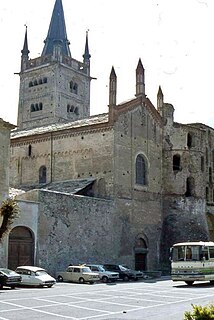Related Research Articles

The Roman Catholic Diocese of Pinerolo is a Latin rite bishopric in the administrative province of Turin of Piedmont region, Northwestern Italy. It is a suffragan of the Metropolitan archbishopric of Turin.

The Diocese of Crema is a Roman Catholic ecclesiastical territory in northern Italy, existing since 1579. It is suffragan to the Archdiocese of Milan. Its seat is Crema Cathedral.

The Diocese of Mantua is a see of the Catholic Church in Italy. It was erected in 804, and is a suffragan of the Archdiocese of Milan. The diocese has produced one Pope and (Latin) Patriarch of Constantinople, and two cardinals.

The Diocese of Biella is a Roman Catholic ecclesiastical territory in northern Italy, created in 1772. It is a suffragan of the Archdiocese of Vercelli. Biella is a city in Piedmont.

The Catholic Diocese of Como in northern Italy, has existed since the fourth century. It is a suffragan of the archdiocese of Milan. The bishops' seat is in Como Cathedral.

The Diocese of Chiavari is a Roman Catholic ecclesiastical territory in Liguria, northern Italy. It was created on 3 December 1892 by Pope Leo XIII in the Bull Romani Pontifices. It is a suffragan of the Archdiocese of Genoa.

The Roman Catholic Diocese of Pescia is in Tuscany, about 41 miles (66 km) west of Florence. It is a suffragan of the Archdiocese of Pisa.

The Roman Catholic Diocese of Susa, in Piedmont (Italy), was established in 1772. It is a suffragan of the archdiocese of Turin. The diocese and the city of Susa lie on the main route that leads to Italy from the Mont Cenis Pass and the Col de Montgenèvre.

The Italian Catholic Diocese of San Miniato is in Tuscany. It is a suffragan of the archdiocese of Florence.

Giuseppe II Pozzobonelli was an Italian Cardinal and the Archbishop of Milan from 1743 to 1783.

Giuseppe Archinto was an Italian diplomat, Cardinal and Archbishop of Milan from 1699 to 1712.

Carlo III Gaetano Stampa (1667–1742) was an Italian Cardinal and Archbishop of Milan from 1737 to 1742.

Filippo Maria Visconti (1721–1801) was the Archbishop of Milan from 1784 to 1801.

Enrico Tazzoli was an Italian patriot and priest, the best known of the Belfiore martyrs.

Giovanni Corti was an Italian priest who became Bishop of Mantua. He supported the cause of Italian reunification at a time when his diocese was under Austrian rule, although he defended the temporal powers of the Pope.
Giovanni Battista Bellé was an Italian priest who became Bishop of Mantua, based in the city of Mantua, Italy.

Pietro Rota was an Italian priest who became Bishop of Mantua, based in the city of Mantua, Northern Italy. He was given the mandate of restoring the diocese to obedience to the Pope after succeeding a popular liberal bishop who had supported Italian unification and the surrender of the Pope's temporal powers. He was harassed by the civil authorities, and was not allowed to take his seat.

The Diocese of Colle di Val d’Elsa was a Roman Catholic diocese located in the town of Colle di Val d'Elsa in Tuscany, Italy, in the province of Siena. The diocese was established by Pope Clement VIII on 5 June 1592, in the bull "Cum Super Universas", with territory taken from the Archdiocese of Florence, the Archdiocese of Siena, the Diocese of Fiesole, and the Diocese of Volterra. The new diocese was made a suffragan of the metropolitanate of Florence. On 18 September 1782 the diocese gained additional territory from Diocese of Volterra. In 1986, it was suppressed.
Vincenzo Agnello Suardi was a Roman Catholic prelate who served as Bishop of Mantua (1620–1644) and Bishop of Alba (1616–1620).
Giuseppe Olgiati was a Roman Catholic prelate who served as Bishop of Como (1711–1735) and Bishop of Parma (1694–1711).
References
Citations
Sources
- Cheney, David M. (2013). "Bishop Giuseppe Maria Bozzi" . Retrieved 2013-09-08.CS1 maint: ref=harv (link)[ self-published source ]
- "Dal 1700 al 1900". Diocesi di Mantova. Archived from the original on 2013-08-26. Retrieved 2013-09-08.
- Volpi, Luigi, Monsignor (1999). "Parrocchia San Pietro - Abbiategrasso".CS1 maint: ref=harv (link)